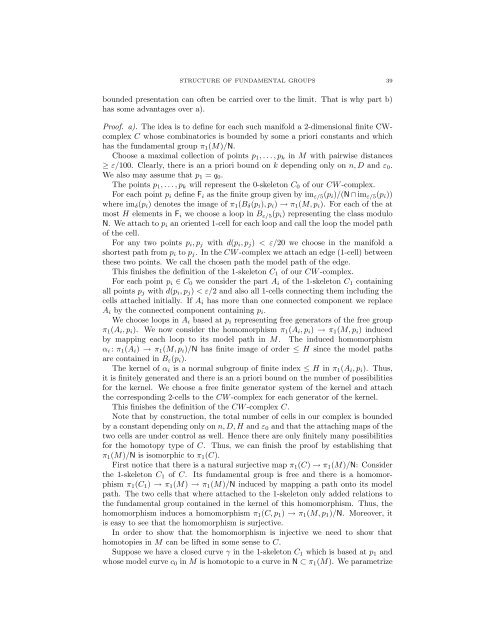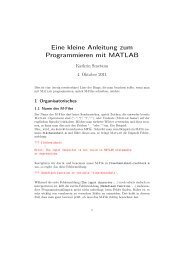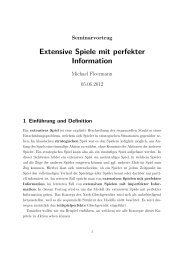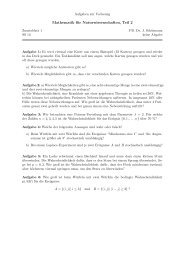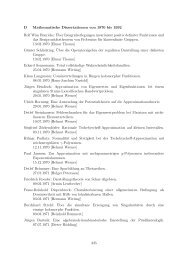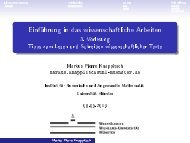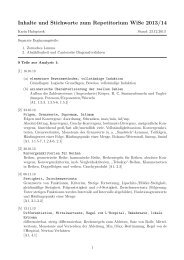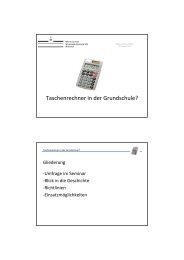Margulis Lemma
Margulis Lemma
Margulis Lemma
Create successful ePaper yourself
Turn your PDF publications into a flip-book with our unique Google optimized e-Paper software.
STRUCTURE OF FUNDAMENTAL GROUPS 39<br />
bounded presentation can often be carried over to the limit. That is why part b)<br />
has some advantages over a).<br />
Proof. a). The idea is to define for each such manifold a 2-dimensional finite CWcomplex<br />
C whose combinatorics is bounded by some a priori constants and which<br />
has the fundamental group π 1 (M)/N.<br />
Choose a maximal collection of points p 1 , . . . , p k in M with pairwise distances<br />
≥ ε/100. Clearly, there is an a priori bound on k depending only on n, D and ε 0 .<br />
We also may assume that p 1 = q 0 .<br />
The points p 1 , . . . , p k will represent the 0-skeleton C 0 of our CW -complex.<br />
For each point p i define F i as the finite group given by im ε/5 (p i )/(N ∩ im ε/5 (p i ))<br />
where im δ (p i ) denotes the image of π 1 (B δ (p i ), p i ) → π 1 (M, p i ). For each of the at<br />
most H elements in F i we choose a loop in B ε/5 (p i ) representing the class modulo<br />
N. We attach to p i an oriented 1-cell for each loop and call the loop the model path<br />
of the cell.<br />
For any two points p i , p j with d(p i , p j ) < ε/20 we choose in the manifold a<br />
shortest path from p i to p j . In the CW -complex we attach an edge (1-cell) between<br />
these two points. We call the chosen path the model path of the edge.<br />
This finishes the definition of the 1-skeleton C 1 of our CW -complex.<br />
For each point p i ∈ C 0 we consider the part A i of the 1-skeleton C 1 containing<br />
all points p j with d(p i , p j ) < ε/2 and also all 1-cells connecting them including the<br />
cells attached initially. If A i has more than one connected component we replace<br />
A i by the connected component containing p i .<br />
We choose loops in A i based at p i representing free generators of the free group<br />
π 1 (A i , p i ). We now consider the homomorphism π 1 (A i , p i ) → π 1 (M, p i ) induced<br />
by mapping each loop to its model path in M. The induced homomorphism<br />
α i : π 1 (A i ) → π 1 (M, p i )/N has finite image of order ≤ H since the model paths<br />
are contained in B ε (p i ).<br />
The kernel of α i is a normal subgroup of finite index ≤ H in π 1 (A i , p i ). Thus,<br />
it is finitely generated and there is an a priori bound on the number of possibilities<br />
for the kernel. We choose a free finite generator system of the kernel and attach<br />
the corresponding 2-cells to the CW -complex for each generator of the kernel.<br />
This finishes the definition of the CW -complex C.<br />
Note that by construction, the total number of cells in our complex is bounded<br />
by a constant depending only on n, D, H and ε 0 and that the attaching maps of the<br />
two cells are under control as well. Hence there are only finitely many possibilities<br />
for the homotopy type of C. Thus, we can finish the proof by establishing that<br />
π 1 (M)/N is isomorphic to π 1 (C).<br />
First notice that there is a natural surjective map π 1 (C) → π 1 (M)/N: Consider<br />
the 1-skeleton C 1 of C. Its fundamental group is free and there is a homomorphism<br />
π 1 (C 1 ) → π 1 (M) → π 1 (M)/N induced by mapping a path onto its model<br />
path. The two cells that where attached to the 1-skeleton only added relations to<br />
the fundamental group contained in the kernel of this homomorphism. Thus, the<br />
homomorphism induces a homomorphism π 1 (C, p 1 ) → π 1 (M, p 1 )/N. Moreover, it<br />
is easy to see that the homomorphism is surjective.<br />
In order to show that the homomorphism is injective we need to show that<br />
homotopies in M can be lifted in some sense to C.<br />
Suppose we have a closed curve γ in the 1-skeleton C 1 which is based at p 1 and<br />
whose model curve c 0 in M is homotopic to a curve in N ⊂ π 1 (M). We parametrize


